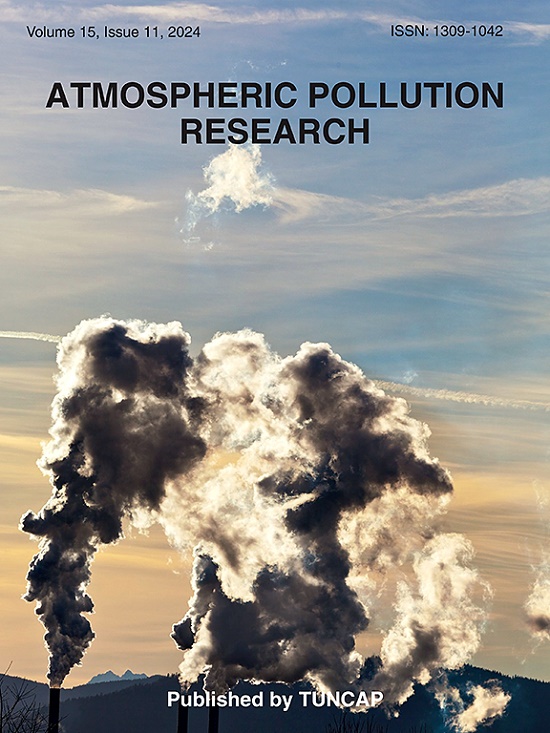阐明城市大气中碳质气溶胶(CA)的大小分辨水平、特征和过程
IF 3.5
3区 环境科学与生态学
Q2 ENVIRONMENTAL SCIENCES
引用次数: 0
摘要
在冬季和夏季,在孟买城市沿海地区使用安德森级联撞击器(ACI)收集尺寸分解颗粒物(PM)。本研究旨在深入了解沿海和热带环境中有机气溶胶的大小分辨组成、特征和过程,这在现有文献中是稀缺的。使用热光学和总碳分析仪分析收集的样品的有机(总和可溶性)和元素碳水平,以及挥发性。两个季节OC值均在0.65 ~ 1.1 μm之间,表明形成过程为气-颗粒凝结。EC在0.43 ~ 0.65 μm处达到峰值,具有机动车排放的特征。OC浓度冬季峰值为12.22±3.65 μg/m3,夏季峰值为3.14±2.87 μg/m3。EC冬季峰值浓度为3.39±1.14 μg/m3,夏季峰值浓度为3.14±1.87 μg/m3。大部分样品的OC/EC比值为>;2,表明次生有机碳(SOC)对OC的贡献显著。夏季PM2.1的SOC/OC比值(9.84±3.14)高于冬季(4.21±1.45),可能是由于光化学活性和臭氧水平增强所致。以挥发性为基础的OC-EC组分最丰富的是OC2、OC4和EC1,表明车辆排放对PM质量的主要贡献。炭- ec /煤烟- ec比率根据大小和季节变化显著(1-16),表明不同来源的影响。在一定尺度和季节,人为VOCs与有机碳具有良好的相关性。本研究表明,粒径分解的碳质气溶胶(CA = EC + OM)对所有PM大小都有显著贡献,为了改善空气质量,需要基于各种贡献过程和CA前体的有针对性的方法。本文章由计算机程序翻译,如有差异,请以英文原文为准。

Elucidating size-resolved levels, characteristics, and processes of carbonaceous aerosols (CA) in an urban atmosphere
An Anderson Cascade Impactor (ACI) was utilised in an urban coastal area of Mumbai to collect size-resolved particulate matter (PM) during winter and summer. This study aims to provide insights into size-resolved composition, characteristics and processes of organic aerosols in a coastal and tropical environment, which is scarce in the available literature. Collected samples were analysed for organic (total and soluble) and elemental carbon levels, and volatility using thermal-optical and total carbon analyzers. OC peaked at 0.65–1.1 μm in both seasons, indicating formation via gas-to-particle condensation. EC showed a peak at 0.43–0.65 μm, characteristic of vehicular emissions. Peak OC concentrations were 12.22 ± 3.65 μg/m3 in winter and 3.14 ± 2.87 μg/m3 in summer. For EC, peak concentrations were 3.39 ± 1.14 μg/m3 in winter and 3.14 ± 1.87 μg/m3 in summer. Most samples showed OC/EC ratios >2, indicating significant secondary organic carbon (SOC) contribution to OC. The SOC/OC ratio in PM2.1 was higher in summer (9.84 ± 3.14) than in winter (4.21 ± 1.45), likely due to enhanced photochemical activity and ozone levels. The most abundant volatility-based OC-EC fractions were OC2, OC4 and EC1, indicating major contribution of vehicular emissions to PM mass. Char-EC/soot-EC ratios varied significantly (1–16) based on size and seasons indicating influence of various sources. Anthropogenic VOCs showed good correlation with SOC at certain sizes and seasons. This study shows that size-resolved carbonaceous aerosol (CA = EC + OM) contributes significantly to all PM sizes and to improve air quality, targeted approach based on various contributing processes and precursors of CA are needed.
求助全文
通过发布文献求助,成功后即可免费获取论文全文。
去求助
来源期刊

Atmospheric Pollution Research
ENVIRONMENTAL SCIENCES-
CiteScore
8.30
自引率
6.70%
发文量
256
审稿时长
36 days
期刊介绍:
Atmospheric Pollution Research (APR) is an international journal designed for the publication of articles on air pollution. Papers should present novel experimental results, theory and modeling of air pollution on local, regional, or global scales. Areas covered are research on inorganic, organic, and persistent organic air pollutants, air quality monitoring, air quality management, atmospheric dispersion and transport, air-surface (soil, water, and vegetation) exchange of pollutants, dry and wet deposition, indoor air quality, exposure assessment, health effects, satellite measurements, natural emissions, atmospheric chemistry, greenhouse gases, and effects on climate change.
 求助内容:
求助内容: 应助结果提醒方式:
应助结果提醒方式:


